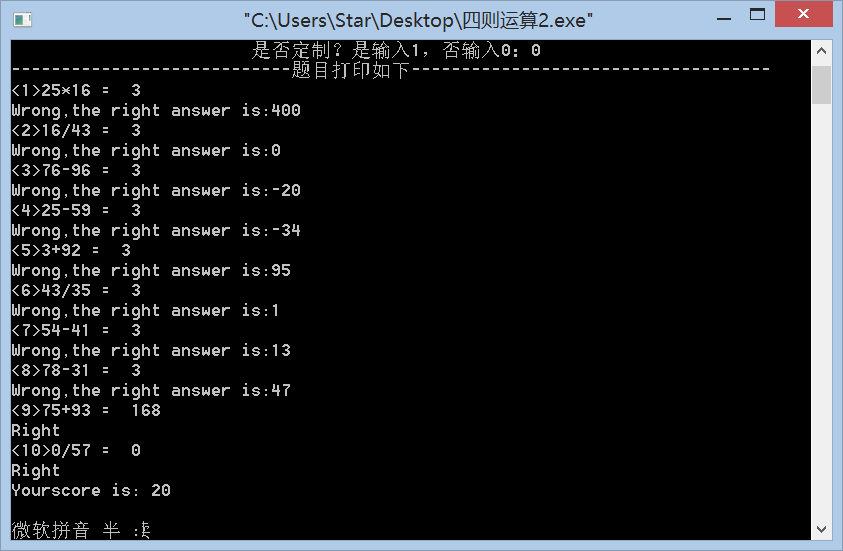一、设计思路
第三版程序在第二版上增加了用户填写答案和自动批改答案功能,并且还能显示一共答对了多少题。
二、程序源代码
#include <stdlib.h>
#include <iostream.h>
#include <conio.h>
#include <time.h>
using namespace std;
void Display1(int,int,int,int,int,int);
void Display2(int [],int,int,int);
int main()
{
int a = 0;
int b = 0;
int mode = 0;//0:加 1:减 2:乘 3:除
int i = 0;
int result = 0;
int score = 0;
int answer = 0;
int c[7]={0,40,1,100,1,1,4};//是否定制,出题数量、是否有乘除、数值上限、数值下限,是否有余数,每行个数。
srand((unsigned)time( NULL ) ); //初始化随机数发生器,使得每次运行生成的随机数不同
printf("---------------------------------------------------------------------------
");
printf(" 欢迎来到二柱子出题系统!
");
printf(" 本系统默认生成10道100以内数字的四则运算题目,每行4道
");
printf(" 是否定制?是输入1,否输入0:");
cin>>c[0];
if(c[0]==0)
{
printf("----------------------------题目打印如下------------------------------------
");
Display1(a,b,mode,result,score,answer) ;
}
else
{
cout<<" 请输入出题数量:";
cin>>c[1];
cout<<" 是否含乘除?是输入1,否输入0:";
cin>>c[2];
cout<<" 数值上限:";
cin>>c[3];
cout<<" 数值下限:";
cin>>c[4];
cout<<" 是否含余数?是输入1,否输入0:";
cin>>c[5];
cout<<" 每行题目数:";
cin>>c[6];
printf("----------------------------题目打印如下------------------------------------
");
Display2(c,a,b,mode);
}
printf("--------------------题目打印完毕,谢谢使用----------------------------------
");
cout<<endl;
return 0;
}
void Display1(int a,int b,int mode,int result,int score,int answer)
{
for(int i=0;i<10;i++) //做三十题
{
a = rand() % 100; //生成一个0~99之间的随机数
b = rand() % 100; //生成一个0~99之间的随机数
mode = rand() % 4; //生成一个0~3之间的随机数,代表运算符
printf("<%d>%d",i+1, a); //打印算式
switch(mode) //确定运算符
{
case 0:
printf("+%d = ", b );
result= a + b; //选择了+运算的正确答案
break;
case 1:
printf("-%d = ", b );
result= a - b; //选择了-运算的正确答案
break;
case 2:
printf("*%d = ", b );
result= a * b; //选择了*运算的正确答案
break;
case 3:
printf("/%d = ", b );
result= a / b; //选择了/运算的正确答案
break;
default:
printf("somethingis wrong!
");
break;
}
scanf("%d", &answer); //输入答案
if(answer == result) //与正确答案一致
{
score+= 10; //加分
printf("Right
");
}
else
{
printf("Wrong,the right answer is:%d
",result); //错开
}
}
printf("Yourscore is: %d
", score);//显示十道题的得分
}
void Display2(int c[],int a,int b,int mode)
{
for(int i=0;i<c[1];i++) //定制题数
{
a = rand() % (c[3]-c[4]+1)+c[4]; //生成限定的随机数
b = rand() % (c[3]-c[4]+1)+c[4]; //生成限定的随机数
if(c[2]==1)
{
mode = rand() % 4; //生成一个0~3之间的随机数,代表运算符
switch(mode) //确定运算符
{
case 0:
printf("%d+%d = ",a, b );
break;
case 1:
printf("%d-%d = ",a, b );
break;
case 2:
printf("%d*%d = ",a, b );
break;
case 3:
if(c[5] == 1) //判断选择是否有余数,如果能有余数
{
printf("%d/%d = ",a, b );
}
else if(a%b!=0) //如果不能有余数
{
i = i-1;
}
else
{
printf("%d/%d = ",a, b );
}
break;
default:
printf("somethingis wrong!
");
break;
}
if((i+1)%c[6]== 0) //判断是否换行
{
printf("
");
}
else
{
for(int j = 0;j<3;j++)
{
printf(" ");
}
}
}
else{
mode = rand() % 2; //生成一个0~1之间的随机数,代表运算符
printf("%d", a); //打印算式
switch(mode) //确定运算符
{
case 0:
printf("+%d =
", b );
break;
case 1:
printf("-%d =
", b );
break;
default:
printf("somethingis wrong!
");
break;
}
if(i%c[6]== 0) //判断是否换行
{
printf("
");
}
else
{
for(int j = 0;j<3;j++)
{
printf(" ");
}
}
}
}
}
运行截图:

五、实验体会总结
这次的程序可以说在第二个的基础上稍加改动,我对第一个函数修改了部分参数,输出10道题,主要是体现功能